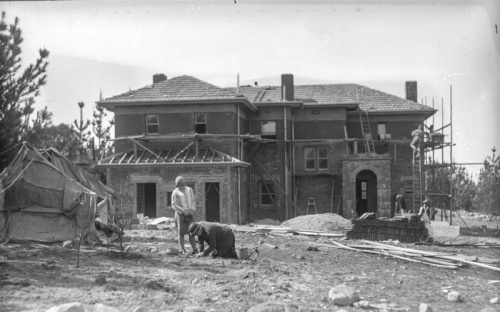
IT’S late 1927, and renderers and roof tilers are working hard on adding the finishing touches to Observatory House, soon to be the grand home of Mount Stromlo Observatory’s founding director Walter Geoffrey Duffield and his young family.
Little by little, the puzzle of the orchard was revealed in the archives.
Outside, Duffield’s wife Doris and daughter Joan plant seeds and saplings on the exposed and rocky mountaintop, surrounded by a dense pine forest.
In an interview in 2004, Joan Duffield remembered: “During the building… my mother wasted no time in getting the garden growing. Likewise, we all put our hands to the wheel and made an orchard on a small plot of vacant land… here were planted apples, pears, oranges, lemons, peaches, apricots, plums and nectarines, which all did well.”
As the orchard grew and flourished, it was harvested and enjoyed by generations of Observatory directors and their families. The orchard was much more than a collection of fruit trees – it also marked the barrier between work and home life for the directors and their families.
One might assume that privacy was difficult to obtain when your office was a mere 100 metres from your front door, but on reflection Professor Don Mathewson, Observatory director 1979-1986, mentioned that the orchard provided the necessary separation, musing that “once you passed through the orchard you were… home”.
While the orchard provided a physical and aesthetic separation between the administration hub of the Commonwealth Solar Observatory Building (1926) and the Director’s Residence (1928), it also forged a strong connection between these two early and very significant buildings for more than 70 years, until the devastating Canberra firestorm in 2003.
Following the significant damage caused by the fire, Mount Stromlo Observatory has recovered steadily with several of the historic buildings restored and much of the landscape regenerated with both natural regrowth and deliberate plantings. However, in place of the Duffield orchard, a makeshift car park had sprung up and, for the last 15 years, that’s the way it stayed.
The Research School of Astronomy and Astrophysics and ANU Heritage have spent several years working on projects to reconnect the local and visiting community to the site including the development of a heritage trail, stabilisation and interpretation of the ruined director’s residence and the reopening of the visitor centre.
It was during these projects that ANU Heritage gained access to thousands of photographs and site plans as well as discovering and undertaking oral histories with past residents.
Little by little, the puzzle of the orchard was revealed in the archives. The words in Joan Duffield’s recollections were soon matched to photographs showing the family planting on the site. By closely examining aerial and other historic photographs from the 1920s until the 1990s, they were able to understand how the site changed over time and understand the layered history of the area.
Using this archival research as their reference, Harris Hobbs Landscapes designed a landscape plan that re-established the formal pathway and included ornamental fruit trees to reflect the original plantings. With funding from the Research School of Astronomy and Astrophysics and the support of an ACT Heritage grant, the car park was relocated and the orchard was replanted in its original location in late 2017.
The restoration of the orchard, as well as installation of the brick path and grassy picnic areas, are a critical step in recovering the unique heritage values of the place. They will also unify the site for visitors to the Observatory and those who walk the Mount Stromlo Heritage Trail, of which the orchard is now a major part.
To follow the self-guided Mount Stromlo Heritage Trail, download the ANU Walks App or the ANU Space App via web download via services.anu.edu.au
The trail is open to visitors during site opening hours, seven days a week, from 8am-6pm.
This article was first published in the “ANU Reporter” Summer 2018 (reporter.anu.edu.au).
Who can be trusted?
In a world of spin and confusion, there’s never been a more important time to support independent journalism in Canberra.
If you trust our work online and want to enforce the power of independent voices, I invite you to make a small contribution.
Every dollar of support is invested back into our journalism to help keep citynews.com.au strong and free.
Thank you,
Ian Meikle, editor




Leave a Reply